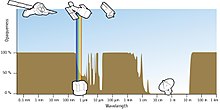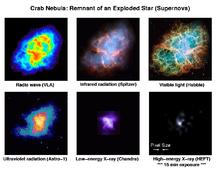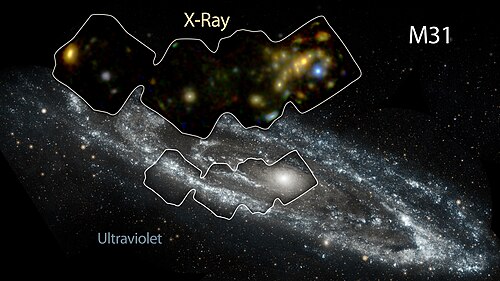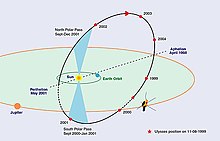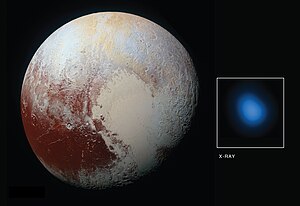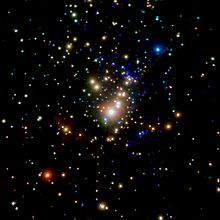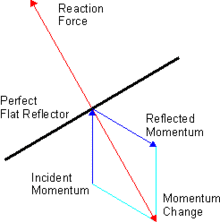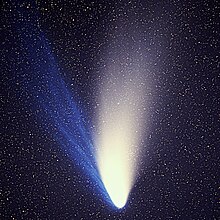X-rays start at ~0.008 nm and extend across the electromagnetic spectrum to ~8 nm, over which the Earth's atmosphere is opaque.
X-ray astronomy is an observational branch of astronomy which deals with the study of X-ray observation and detection from astronomical objects. X-radiation is absorbed by the Earth's atmosphere, so instruments to detect X-rays must be taken to high altitude by balloons, sounding rockets, and satellites. X-ray astronomy is the space science related to a type of space telescope that can see farther than standard light-absorption telescopes, such as the Mauna Kea Observatories, via x-ray radiation.
X-ray emission is expected from astronomical objects that contain extremely hot gases at temperatures from about a million kelvin (K) to hundreds of millions of kelvin (MK). Moreover, the maintenance of the E-layer of ionized gas high in the Earth's Thermosphere also suggested a strong extraterrestrial source of X-rays. Although theory predicted that the Sun
and the stars would be prominent X-ray sources, there was no way to
verify this because Earth's atmosphere blocks most extraterrestrial
X-rays. It was not until ways of sending instrument packages to high
altitude were developed that these X-ray sources could be studied.
The existence of solar X-rays was confirmed early in the rocket age by V-2s converted to sounding rocket
purpose, and the detection of extraterrestrial X-rays has been the
primary or secondary mission of multiple satellites since 1958. The first cosmic (beyond the solar system) X-ray source was discovered by a sounding rocket in 1962. Called Scorpius X-1 (Sco X-1) (the first X-ray source found in the constellation Scorpius),
the X-ray emission of Scorpius X-1 is 10,000 times greater than its
visual emission, whereas that of the Sun is about a million times less.
In addition, the energy output in X-rays is 100,000 times greater than
the total emission of the Sun in all wavelengths.
Many thousands of X-ray sources have since been discovered. In addition, the space between galaxies in galaxy clusters
is filled with a very hot, but very dilute gas at a temperature between
10 and 100 megakelvins (MK). The total amount of hot gas is five to ten
times the total mass in the visible galaxies.
Sounding rocket flights
The first sounding rocket flights for X-ray research were accomplished at the White Sands Missile Range in New Mexico with a V-2 rocket on January 28, 1949. A detector was placed in the nose cone section and the rocket was launched in a suborbital flight to an altitude just above the atmosphere.
X-rays from the Sun were detected by the U.S. Naval Research Laboratory Blossom experiment on board. An Aerobee 150 rocket was launched on June 12, 1962 and it detected the first X-rays from other celestial sources (Scorpius X-1). It is now known that such X-ray sources as Sco X-1 are compact stars, such as neutron stars or black holes.
Material falling into a black hole may emit X-rays, but the black hole
itself does not. The energy source for the X-ray emission is gravity. Infalling gas and dust is heated by the strong gravitational fields of these and other celestial objects. Based on discoveries in this new field of X-ray astronomy, starting with Scorpius X-1, Riccardo Giacconi received the Nobel Prize in Physics in 2002.
The largest drawback to rocket flights is their very short
duration (just a few minutes above the atmosphere before the rocket
falls back to Earth) and their limited field of view.
A rocket launched from the United States will not be able to see
sources in the southern sky; a rocket launched from Australia will not
be able to see sources in the northern sky.
X-ray Quantum Calorimeter (XQC) project
A launch of the Black Brant 8 Microcalorimeter (XQC-2) at the turn of the century is a part of the joint undertaking by the University of Wisconsin–Madison and NASA's Goddard Space Flight Center known as the X-ray Quantum Calorimeter (XQC) project.
In astronomy, the interstellar medium (or ISM) is the gas and cosmic dust that pervade interstellar space: the matter that exists between the star systems within a galaxy. It fills interstellar space and blends smoothly into the surrounding intergalactic medium. The interstellar medium consists of an extremely dilute (by terrestrial standards) mixture of ions, atoms, molecules, larger dust grains, cosmic rays, and (galactic) magnetic fields. The energy that occupies the same volume, in the form of electromagnetic radiation, is the interstellar radiation field.
Of interest is the hot ionized medium (HIM) consisting of a coronal cloud ejection from star surfaces at 106-107 K which emits X-rays. The ISM is turbulent and full of structure on all spatial scales. Stars are born deep inside large complexes of molecular clouds, typically a few parsecs in size. During their lives and deaths, stars interact physically with the ISM. Stellar winds from young clusters of stars (often with giant or supergiant HII regions surrounding them) and shock waves created by supernovae inject enormous amounts of energy into their surroundings, which leads to hypersonic turbulence. The resultant structures are stellar wind bubbles and superbubbles of hot gas. The Sun is currently traveling through the Local Interstellar Cloud, a denser region in the low-density Local Bubble.
To measure the spectrum of the diffuse X-ray emission from the interstellar medium over the energy range 0.07 to 1 keV, NASA launched a Black Brant 9 from White Sands Missile Range, New Mexico on May 1, 2008. The Principal Investigator for the mission is Dr. Dan McCammon of the University of Wisconsin–Madison.
Balloons
Balloon flights can carry instruments to altitudes of up to 40 km
above sea level, where they are above as much as 99.997% of the Earth's
atmosphere. Unlike a rocket where data are collected during a brief few
minutes, balloons are able to stay aloft for much longer. However, even
at such altitudes, much of the X-ray spectrum is still absorbed. X-rays with energies less than 35 keV (5,600 aJ) cannot reach balloons. On July 21, 1964, the Crab Nebula
supernova remnant was discovered to be a hard X-ray (15–60 keV) source
by a scintillation counter flown on a balloon launched from Palestine, Texas, United States. This was likely the first balloon-based detection of X-rays from a discrete cosmic X-ray source.
High-energy focusing telescope
The Crab Nebula
is a remnant of an exploded star. This image shows the Crab Nebula in
various energy bands, including a hard X-ray image from the HEFT data
taken during its 2005 observation run. Each image is 6′ wide.
The high-energy focusing telescope (HEFT) is a balloon-borne
experiment to image astrophysical sources in the hard X-ray (20–100 keV)
band.
Its maiden flight took place in May 2005 from Fort Sumner, New Mexico,
USA. The angular resolution of HEFT is c. 1.5'. Rather than using a
grazing-angle X-ray telescope, HEFT makes use of a novel tungsten-silicon
multilayer coatings to extend the reflectivity of nested
grazing-incidence mirrors beyond 10 keV. HEFT has an energy resolution
of 1.0 keV full width at half maximum
at 60 keV. HEFT was launched for a 25-hour balloon flight in May 2005.
The instrument performed within specification and observed Tau X-1, the Crab Nebula.
High-resolution gamma-ray and hard X-ray spectrometer (HIREGS)
A
balloon-borne experiment called the High-resolution gamma-ray and hard
X-ray spectrometer (HIREGS) observed X-ray and gamma-rays emissions from
the Sun and other astronomical objects. It was launched from McMurdo Station, Antarctica in December 1991 and 1992. Steady winds carried the balloon on a circumpolar flight lasting about two weeks each time.
Rockoons
Navy Deacon rockoon photographed just after a shipboard launch in July 1956.
The rockoon (a portmanteau of rocket and balloon) was a solid fuel rocket
that, rather than being immediately lit while on the ground, was first
carried into the upper atmosphere by a gas-filled balloon. Then, once
separated from the balloon at its maximum height, the rocket was
automatically ignited. This achieved a higher altitude, since the rocket
did not have to move through the lower thicker air layers that would
have required much more chemical fuel.
The original concept of "rockoons" was developed by Cmdr. Lee Lewis, Cmdr. G. Halvorson, S. F. Singer, and James A. Van Allen during the Aerobee rocket firing cruise of the USS Norton Sound on March 1, 1949.
From July 17 to July 27, 1956, the Naval Research Laboratory (NRL) shipboard launched eight Deacon rockoons for solar ultraviolet and X-ray observations at ~30° N ~121.6° W, southwest of San Clemente Island, apogee: 120 km.
X-ray astronomy satellite
X-ray astronomy satellites study X-ray emissions from celestial
objects. Satellites, which can detect and transmit data about the X-ray
emissions are deployed as part of branch of space science known as X-ray
astronomy. Satellites are needed because X-radiation is absorbed by the
Earth's atmosphere, so instruments to detect X-rays must be taken to
high altitude by balloons, sounding rockets, and satellites.
X-ray telescopes and mirrors
The Swift Gamma-Ray Burst Mission contains a grazing incidence Wolter I telescope (XRT) to focus X-rays onto a state-of-the-art CCD.
X-ray telescopes (XRTs) have varying directionality or imaging
ability based on glancing angle reflection rather than refraction or
large deviation reflection.
This limits them to much narrower fields of view than visible or UV
telescopes. The mirrors can be made of ceramic or metal foil.
The first X-ray telescope in astronomy was used to observe the
Sun. The first X-ray picture (taken with a grazing incidence telescope)
of the Sun was taken in 1963, by a rocket-borne telescope. On April 19,
1960 the very first X-ray image of the sun was taken using a pinhole
camera on an Aerobee-Hi rocket.
The utilization of X-ray mirrors for extrasolar X-ray astronomy simultaneously requires:
- the ability to determine the location at the arrival of an X-ray photon in two dimensions and
- a reasonable detection efficiency.
X-ray astronomy detectors
Proportional Counter Array on the Rossi X-ray Timing Explorer (RXTE) satellite.
X-ray astronomy detectors have been designed and configured primarily
for energy and occasionally for wavelength detection using a variety of
techniques usually limited to the technology of the time.
X-ray detectors collect individual X-rays (photons of X-ray
electromagnetic radiation) and count the number of photons collected
(intensity), the energy (0.12 to 120 keV) of the photons collected,
wavelength (c. 0.008–8 nm), or how fast the photons are detected (counts
per hour), to tell us about the object that is emitting them.
Astrophysical sources of X-rays
Andromeda Galaxy – in high-energy X-ray and ultraviolet light (released 5 January 2016).
This
light curve of Her X-1 shows long term and medium term variability.
Each pair of vertical lines delineate the eclipse of the compact object
behind its companion star. In this case, the companion is a two
solar-mass star with a radius of nearly four times that of our Sun. This
eclipse shows us the orbital period of the system, 1.7 days.
Several types of astrophysical objects emit, fluoresce, or reflect X-rays, from galaxy clusters, through black holes in active galactic nuclei (AGN) to galactic objects such as supernova remnants, stars, and binary stars containing a white dwarf (cataclysmic variable stars and super soft X-ray sources), neutron star or black hole (X-ray binaries). Some solar system bodies emit X-rays, the most notable being the Moon,
although most of the X-ray brightness of the Moon arises from reflected
solar X-rays. A combination of many unresolved X-ray sources is thought
to produce the observed X-ray background. The X-ray continuum can arise from bremsstrahlung, black-body radiation, synchrotron radiation, or what is called inverse Compton scattering
of lower-energy photons by relativistic electrons, knock-on collisions
of fast protons with atomic electrons, and atomic recombination, with or
without additional electron transitions.
An intermediate-mass X-ray binary
(IMXB) is a binary star system where one of the components is a neutron
star or a black hole. The other component is an intermediate mass star.
Hercules X-1
is composed of a neutron star accreting matter from a normal star (HZ
Herculis) probably due to Roche lobe overflow. X-1 is the prototype for
the massive X-ray binaries although it falls on the borderline, ~2 M☉, between high- and low-mass X-ray binaries.
Celestial X-ray sources
The celestial sphere has been divided into 88 constellations. The International Astronomical Union
(IAU) constellations are areas of the sky. Each of these contains
remarkable X-ray sources. Some of them have been identified from
astrophysical modeling to be galaxies or black holes at the centers of galaxies. Some are pulsars.
As with sources already successfully modeled by X-ray astrophysics,
striving to understand the generation of X-rays by the apparent source
helps to understand the Sun, the universe as a whole, and how these affect us on Earth.
Constellations are an astronomical device for handling observation and
precision independent of current physical theory or interpretation.
Astronomy has been around for a long time. Physical theory changes with
time. With respect to celestial X-ray sources, X-ray astrophysics tends
to focus on the physical reason for X-ray brightness, whereas X-ray
astronomy tends to focus on their classification, order of discovery,
variability, resolvability, and their relationship with nearby sources
in other constellations.
This ROSAT PSPC false-color image is of a portion of a nearby stellar wind superbubble (the Orion-Eridanus Superbubble) stretching across Eridanus and Orion.
Within the constellations Orion and Eridanus and stretching across them is a soft X-ray "hot spot" known as the Orion-Eridanus Superbubble, the Eridanus Soft X-ray Enhancement, or simply the Eridanus Bubble,
a 25° area of interlocking arcs of Hα emitting filaments. Soft X-rays
are emitted by hot gas (T ~ 2–3 MK) in the interior of the superbubble.
This bright object forms the background for the "shadow" of a filament
of gas and dust. The filament is shown by the overlaid contours, which
represent 100 micrometre emission from dust at a temperature of about 30
K as measured by IRAS.
Here the filament absorbs soft X-rays between 100 and 300 eV,
indicating that the hot gas is located behind the filament. This
filament may be part of a shell of neutral gas that surrounds the hot
bubble. Its interior is energized by ultraviolet
(UV) light and stellar winds from hot stars in the Orion OB1
association. These stars energize a superbubble about 1200 lys across
which is observed in the visual (Hα) and X-ray portions of the spectrum.
Proposed (future) X-ray observatory satellites
There are several projects that are proposed for X-ray observatory satellites. See main article link above.
Explorational X-ray astronomy
Ulysses' second orbit: it arrived at Jupiter on February 8, 1992, for a swing-by maneuver that increased its inclination to the ecliptic by 80.2 degrees.
Usually observational astronomy is considered to occur on Earth's surface (or beneath it in neutrino astronomy).
The idea of limiting observation to Earth includes orbiting the Earth.
As soon as the observer leaves the cozy confines of Earth, the observer
becomes a deep space explorer. Except for Explorer 1 and Explorer 3 and the earlier satellites in the series, usually if a probe is going to be a deep space explorer it leaves the Earth or an orbit around the Earth.
For a satellite or space probe to qualify as a deep space X-ray
astronomer/explorer or "astronobot"/explorer, all it needs to carry
aboard is an XRT or X-ray detector and leave Earth's orbit.
Ulysses was launched October 6, 1990, and reached Jupiter for its "gravitational slingshot"
in February 1992. It passed the south solar pole in June 1994 and
crossed the ecliptic equator in February 1995. The solar X-ray and
cosmic gamma-ray burst experiment (GRB) had 3 main objectives: study and
monitor solar flares, detect and localize cosmic gamma-ray bursts, and
in-situ detection of Jovian aurorae. Ulysses was the first satellite
carrying a gamma burst detector which went outside the orbit of Mars.
The hard X-ray detectors operated in the range 15–150 keV. The detectors
consisted of 23-mm thick × 51-mm diameter CsI(Tl) crystals mounted via
plastic light tubes to photomultipliers. The hard detector changed its
operating mode depending on (1) measured count rate, (2) ground command,
or (3) change in spacecraft telemetry mode. The trigger level was
generally set for 8-sigma above background and the sensitivity is 10−6 erg/cm2 (1 nJ/m2).
When a burst trigger is recorded, the instrument switches to record
high resolution data, recording it to a 32-kbit memory for a slow
telemetry read out. Burst data consist of either 16 s of 8-ms resolution
count rates or 64 s of 32-ms count rates from the sum of the 2
detectors. There were also 16 channel energy spectra from the sum of the
2 detectors (taken either in 1, 2, 4, 16, or 32 second integrations).
During 'wait' mode, the data were taken either in 0.25 or 0.5 s
integrations and 4 energy channels (with shortest integration time being
8 s). Again, the outputs of the 2 detectors were summed.
The Ulysses soft X-ray detectors consisted of 2.5-mm thick × 0.5 cm2 area Si surface barrier detectors. A 100 mg/cm2
beryllium foil front window rejected the low energy X-rays and defined a
conical FOV of 75° (half-angle). These detectors were passively cooled
and operate in the temperature range −35 to −55 °C. This detector had 6
energy channels, covering the range 5–20 keV.
X-Rays from Pluto
Theoretical X-ray astronomy
Theoretical X-ray astronomy is a branch of theoretical astronomy that deals with the theoretical astrophysics and theoretical astrochemistry of X-ray generation, emission, and detection as applied to astronomical objects.
Like theoretical astrophysics, theoretical X-ray astronomy uses a wide variety of tools which include analytical models to approximate the behavior of a possible X-ray source and computational numerical simulations
to approximate the observational data. Once potential observational
consequences are available they can be compared with experimental
observations. Observers can look for data that refutes a model or helps
in choosing between several alternate or conflicting models.
Theorists also try to generate or modify models to take into
account new data. In the case of an inconsistency, the general tendency
is to try to make minimal modifications to the model to fit the data. In
some cases, a large amount of inconsistent data over time may lead to
total abandonment of a model.
Most of the topics in astrophysics, astrochemistry, astrometry, and other fields that are branches of astronomy
studied by theoreticians involve X-rays and X-ray sources. Many of the
beginnings for a theory can be found in an Earth-based laboratory where
an X-ray source is built and studied.
Dynamos
Dynamo theory describes the process through which a rotating, convecting, and electrically conducting fluid acts to maintain a magnetic field.
This theory is used to explain the presence of anomalously long-lived
magnetic fields in astrophysical bodies. If some of the stellar magnetic
fields are really induced by dynamos, then field strength might be
associated with rotation rate.
Astronomical models
Images released to celebrate the International Year of Light 2015
(Chandra X-Ray Observatory).
(Chandra X-Ray Observatory).
From the observed X-ray spectrum, combined with spectral emission
results for other wavelength ranges, an astronomical model addressing
the likely source of X-ray emission can be constructed. For example,
with Scorpius X-1 the X-ray spectrum steeply drops off as X-ray energy
increases up to 20 keV, which is likely for a thermal-plasma mechanism.
In addition, there is no radio emission, and the visible continuum is
roughly what would be expected from a hot plasma fitting the observed
X-ray flux. The plasma could be a coronal cloud
of a central object or a transient plasma, where the energy source is
unknown, but could be related to the idea of a close binary.
In the Crab Nebula X-ray spectrum there are three features that
differ greatly from Scorpius X-1: its spectrum is much harder, its
source diameter is in light-years (ly)s, not astronomical units (AU), and its radio and optical synchrotron emission are strong.
Its overall X-ray luminosity rivals the optical emission and could be
that of a nonthermal plasma. However, the Crab Nebula appears as an
X-ray source that is a central freely expanding ball of dilute plasma,
where the energy content is 100 times the total energy content of the
large visible and radio portion, obtained from the unknown source.
The "Dividing Line" as giant stars evolve to become red giants also coincides with the Wind and Coronal Dividing Lines. To explain the drop in X-ray emission across these dividing lines, a number of models have been proposed:
- low transition region densities, leading to low emission in coronae,
- high-density wind extinction of coronal emission,
- only cool coronal loops become stable,
- changes in a magnetic field structure to that an open topology, leading to a decrease of magnetically confined plasma, or
- changes in the magnetic dynamo character, leading to the disappearance of stellar fields leaving only small-scale, turbulence-generated fields among red giants.
Analytical X-ray astronomy
High-mass X-ray binaries (HMXBs) are composed of OB supergiant companion stars and compact objects, usually neutron stars (NS) or black holes
(BH). Supergiant X-ray binaries (SGXBs) are HMXBs in which the compact
objects orbit massive companions with orbital periods of a few days
(3–15 d), and in circular (or slightly eccentric) orbits. SGXBs show
typical the hard X-ray spectra of accreting pulsars and most show strong absorption as obscured HMXBs. X-ray luminosity (Lx) increases up to 1036 erg·s−1 (1029 watts).
The mechanism triggering the different temporal behavior observed between the classical SGXBs and the recently discovered supergiant fast X-ray transients (SFXT)s is still debated.
Stellar X-ray astronomy
Stellar X-ray astronomy is said to have started on April 5, 1974, with the detection of X-rays from Capella.
A rocket flight on that date briefly calibrated its attitude control
system when a star sensor pointed the payload axis at Capella (α Aur).
During this period, X-rays in the range 0.2–1.6 keV were detected by an
X-ray reflector system co-aligned with the star sensor. The X-ray luminosity of Lx = 1031 erg·s−1 (1024 W) is four orders of magnitude above the Sun's X-ray luminosity.
Stellar coronae
Coronal stars, or stars within a coronal cloud, are ubiquitous among the stars in the cool half of the Hertzsprung-Russell diagram. Experiments with instruments aboard Skylab and Copernicus have been used to search for soft X-ray emission in the energy range ~0.14–0.284 keV from stellar coronae. The experiments aboard ANS
succeeded in finding X-ray signals from Capella and Sirius (α CMa).
X-ray emission from an enhanced solar-like corona was proposed for the
first time. The high temperature of Capella's corona as obtained from the first coronal X-ray spectrum of Capella using HEAO 1 required magnetic confinement unless it was a free-flowing coronal wind.
In 1977 Proxima Centauri is discovered to be emitting high-energy radiation in the XUV. In 1978, α Cen was identified as a low-activity coronal source. With the operation of the Einstein
observatory, X-ray emission was recognized as a characteristic feature
common to a wide range of stars covering essentially the whole
Hertzsprung-Russell diagram. The Einstein initial survey led to significant insights:
- X-ray sources abound among all types of stars, across the Hertzsprung-Russell diagram and across most stages of evolution,
- the X-ray luminosities and their distribution along the main sequence were not in agreement with the long-favored acoustic heating theories, but were now interpreted as the effect of magnetic coronal heating, and
- stars that are otherwise similar reveal large differences in their X-ray output if their rotation period is different.
To fit the medium-resolution spectrum of UX Ari, subsolar abundances were required.
Stellar X-ray astronomy is contributing toward a deeper understanding of
- magnetic fields in magnetohydrodynamic dynamos,
- the release of energy in tenuous astrophysical plasmas through various plasma-physical processes, and
- the interactions of high-energy radiation with the stellar environment.
Current wisdom has it that the massive coronal main sequence stars
are late-A or early F stars, a conjecture that is supported both by
observation and by theory.
Young, low-mass stars
A Chandra X-ray image of the Cluster of newly formed stars in the Orion Nebula.
Newly formed stars are known as pre-main-sequence stars during the stage of stellar evolution before they reach the main-sequence. Stars in this stage (ages <10 10="" coronae.="" emission="" however="" in="" is="" million="" produce="" stellar="" sup="" their="" x-ray="" x-rays="" years="">3
to 105 times stronger than for main-sequence stars of similar masses.
X-ray emission for pre–main-sequence stars was discovered by the Einstein Observatory.
This X-ray emission is primarily produced by magnetic reconnection
flares in the stellar coronae, with many small flares contributing to
the "quiescent" X-ray emission from these stars.
Pre–main sequence stars have large convection zones, which in turn
drive strong dynamos, producing strong surface magnetic fields. This
leads to the high X-ray emission from these stars, which lie in the
saturated X-ray regime, unlike main-sequence stars that show rotational modulation of X-ray emission. Other sources of X-ray emission include accretion hotspots and collimated outflows.
X-ray emission as an indicator of stellar youth is important for
studies of star-forming regions. Most star-forming regions in the Milky
Way Galaxy are projected on Galactic-Plane fields
with numerous unrelated field stars. It is often impossible to
distinguish members of a young stellar cluster from field-star
contaminants using optical and infrared images alone. X-ray emission can
easily penetrate moderate absorption from molecular clouds, and can be
used to identify candidate cluster members.
Unstable winds
Given the lack of a significant outer convection zone, theory predicts the absence of a magnetic dynamo in earlier A stars. In early stars of spectral type O and B, shocks developing in unstable winds are the likely source of X-rays.
Coolest M dwarfs
Beyond
spectral type M5, the classical αω dynamo can no longer operate as the
internal structure of dwarf stars changes significantly: they become
fully convective. As a distributed (or α2)
dynamo may become relevant, both the magnetic flux on the surface and
the topology of the magnetic fields in the corona should systematically
change across this transition, perhaps resulting in some discontinuities
in the X-ray characteristics around spectral class dM5.
However, observations do not seem to support this picture: long-time
lowest-mass X-ray detection, VB 8 (M7e V), has shown steady emission at
levels of X-ray luminosity (LX) ≈ 1026 erg·s−1 (1019 W) and flares up to an order of magnitude higher. Comparison with other late M dwarfs shows a rather continuous trend.
Strong X-ray emission from Herbig Ae/Be stars
Herbig Ae/Be stars are pre-main sequence stars. As to their X-ray emission properties, some are
- reminiscent of hot stars,
- others point to coronal activity as in cool stars, in particular the presence of flares and very high temperatures.
The nature of these strong emissions has remained controversial with models including
- unstable stellar winds,
- colliding winds,
- magnetic coronae,
- disk coronae,
- wind-fed magnetospheres,
- accretion shocks,
- the operation of a shear dynamo,
- the presence of unknown late-type companions.
K giants
The
FK Com stars are giants of spectral type K with an unusually rapid
rotation and signs of extreme activity. Their X-ray coronae are among
the most luminous (LX ≥ 1032 erg·s−1 or 1025 W) and the hottest known with dominant temperatures up to 40 MK.
However, the current popular hypothesis involves a merger of a close
binary system in which the orbital angular momentum of the companion is
transferred to the primary.
Pollux is the brightest star in the constellation Gemini,
despite its Beta designation, and the 17th brightest in the sky. Pollux
is a giant orange K star that makes an interesting color contrast with
its white "twin", Castor. Evidence has been found for a hot, outer,
magnetically supported corona around Pollux, and the star is known to be
an X-ray emitter.
Eta Carinae
Classified as a Peculiar star, Eta Carinae exhibits a superstar at its center as seen in this image from Chandra X-ray Observatory. Credit: Chandra Science Center and NASA.
New X-ray observations by the Chandra X-ray Observatory
show three distinct structures: an outer, horseshoe-shaped ring about 2
light years in diameter, a hot inner core about 3 light-months in
diameter, and a hot central source less than 1 light-month in diameter
which may contain the superstar that drives the whole show. The outer
ring provides evidence of another large explosion that occurred over
1,000 years ago. These three structures around Eta Carinae
are thought to represent shock waves produced by matter rushing away
from the superstar at supersonic speeds. The temperature of the
shock-heated gas ranges from 60 MK in the central regions to 3 MK on the
horseshoe-shaped outer structure. "The Chandra image contains some
puzzles for existing ideas of how a star can produce such hot and
intense X-rays," says Prof. Kris Davidson of the University of Minnesota. Davidson is principal investigator for the Eta Carina observations by the Hubble Space telescope.
"In the most popular theory, X-rays are made by colliding gas streams
from two stars so close together that they'd look like a point source to
us. But what happens to gas streams that escape to farther distances?
The extended hot stuff in the middle of the new image gives demanding
new conditions for any theory to meet."
Amateur X-ray astronomy
Collectively, amateur astronomers observe a variety of celestial
objects and phenomena sometimes with equipment that they build
themselves. The United States Air Force Academy
(USAFA) is the home of the US's only undergraduate satellite program,
and has and continues to develop the FalconLaunch sounding rockets.
In addition to any direct amateur efforts to put X-ray astronomy
payloads into space, there are opportunities that allow
student-developed experimental payloads to be put on board commercial
sounding rockets as a free-of-charge ride.
There are major limitations to amateurs observing and reporting
experiments in X-ray astronomy: the cost of building an amateur rocket
or balloon to place a detector high enough and the cost of appropriate
parts to build a suitable X-ray detector.
History of X-ray astronomy
NRL
scientists J. D. Purcell, C. Y. Johnson, and Dr. F. S. Johnson are
among those recovering instruments from a V-2 used for upper atmospheric
research above the New Mexico desert. This is V-2 number 54, launched
January 18, 1951, (photo by Dr. Richard Tousey, NRL).
In 1927, E.O. Hulburt of the US Naval Research Laboratory and associates Gregory Breit and Merle A. Tuve of the Carnegie Institution of Washington explored the possibility of equipping Robert H. Goddard's
rockets to explore the upper atmosphere. "Two years later, he proposed
an experimental program in which a rocket might be instrumented to
explore the upper atmosphere, including detection of ultraviolet
radiation and X-rays at high altitudes".
In the late 1930s, the presence of a very hot, tenuous gas
surrounding the Sun was inferred indirectly from optical coronal lines
of highly ionized species. The Sun has been known to be surrounded by a hot tenuous corona. In the mid-1940s radio observations revealed a radio corona around the Sun.
The beginning of the search for X-ray sources from above the Earth's atmosphere was on August 5, 1948 12:07 GMT. A US Army (formerly German) V-2 rocket as part of Project Hermes was launched from White Sands Proving Grounds. The first solar X-rays were recorded by T. Burnight.
Through the 1960s, 70s, 80s, and 90s, the sensitivity of
detectors increased greatly during the 60 years of X-ray astronomy. In
addition, the ability to focus X-rays has developed enormously—allowing
the production of high-quality images of many fascinating celestial
objects.
Major questions in X-ray astronomy
As X-ray astronomy uses a major spectral probe to peer into source, it is a valuable tool in efforts to understand many puzzles.
Stellar magnetic fields
Magnetic
fields are ubiquitous among stars, yet we do not understand precisely
why, nor have we fully understood the bewildering variety of plasma
physical mechanisms that act in stellar environments. Some stars, for example, seem to have magnetic fields, fossil stellar magnetic fields left over from their period of formation, while others seem to generate the field anew frequently.
Extrasolar X-ray source astrometry
With the initial detection of an extrasolar X-ray source, the first
question usually asked is "What is the source?" An extensive search is
often made in other wavelengths such as visible or radio for possible
coincident objects. Many of the verified X-ray locations still do not
have readily discernible sources. X-ray astrometry becomes a serious concern that results in ever greater demands for finer angular resolution and spectral radiance.
There are inherent difficulties in making X-ray/optical,
X-ray/radio, and X-ray/X-ray identifications based solely on positional
coincidents, especially with handicaps in making identifications, such
as the large uncertainties in positional determinants made from balloons
and rockets, poor source separation in the crowded region toward the
galactic center, source variability, and the multiplicity of source
nomenclature.
X‐ray source counterparts to stars can be identified by
calculating the angular separation between source centroids and position
of the star. The maximum allowable separation is a compromise between a
larger value to identify as many real matches as possible and a smaller
value to minimize the probability of spurious matches. "An adopted
matching criterion of 40" finds nearly all possible X‐ray source matches
while keeping the probability of any spurious matches in the sample to
3%."
Solar X-ray astronomy
All of the detected X-ray sources at, around, or near the Sun appear to be associated with processes in the corona, which is its outer atmosphere.
Coronal heating problem
In the area of solar X-ray astronomy, there is the coronal heating problem. The photosphere of the Sun has an effective temperature of 5,570 K yet its corona has an average temperature of 1–2 × 106 K. However, the hottest regions are 8–20 × 106 K. The high temperature of the corona shows that it is heated by something other than direct heat conduction from the photosphere.
It is thought that the energy necessary to heat the corona is
provided by turbulent motion in the convection zone below the
photosphere, and two main mechanisms have been proposed to explain
coronal heating. The first is wave heating, in which sound, gravitational or magnetohydrodynamic waves are produced by turbulence in the convection zone. These waves travel upward and dissipate in the corona, depositing their energy in the ambient gas in the form of heat. The other is magnetic heating, in which magnetic energy is continuously built up by photospheric motion and released through magnetic reconnection in the form of large solar flares and myriad similar but smaller events—nanoflares.
Currently, it is unclear whether waves are an efficient heating mechanism. All waves except Alfvén waves have been found to dissipate or refract before reaching the corona.
In addition, Alfvén waves do not easily dissipate in the corona.
Current research focus has therefore shifted towards flare heating
mechanisms.
Coronal mass ejection
A coronal mass ejection (CME) is an ejected plasma consisting primarily of electrons and protons
(in addition to small quantities of heavier elements such as helium,
oxygen, and iron), plus the entraining coronal closed magnetic field
regions. Evolution of these closed magnetic structures in response to
various photospheric motions over different time scales (convection,
differential rotation, meridional circulation) somehow leads to the CME.
Small-scale energetic signatures such as plasma heating (observed as
compact soft X-ray brightening) may be indicative of impending CMEs.
The soft X-ray sigmoid (an S-shaped intensity of soft X-rays) is
an observational manifestation of the connection between coronal
structure and CME production.
"Relating the sigmoids at X-ray (and other) wavelengths to magnetic
structures and current systems in the solar atmosphere is the key to
understanding their relationship to CMEs."
The first detection of a Coronal mass ejection (CME) as such was
made on December 1, 1971 by R. Tousey of the US Naval Research
Laboratory using OSO 7. Earlier observations of coronal transients or even phenomena observed visually during solar eclipses are now understood as essentially the same thing.
The largest geomagnetic perturbation, resulting presumably from a
"prehistoric" CME, coincided with the first-observed solar flare, in
1859. The flare was observed visually by Richard Christopher Carrington and the geomagnetic storm was observed with the recording magnetograph at Kew Gardens. The same instrument recorded a crotchet,
an instantaneous perturbation of the Earth's ionosphere by ionizing
soft X-rays. This could not easily be understood at the time because it
predated the discovery of X-rays (by Roentgen) and the recognition of the ionosphere (by Kennelly and Heaviside).
Exotic X-ray sources
A microquasar is a smaller cousin of a quasar that is a radio emitting X-ray binary, with an often resolvable pair of radio jets.
LSI+61°303 is a periodic, radio-emitting binary system that is also the gamma-ray source, CG135+01.
Observations are revealing a growing number of recurrent X-ray transients,
characterized by short outbursts with very fast rise times (tens of
minutes) and typical durations of a few hours that are associated with
OB supergiants and hence define a new class of massive X-ray binaries: Supergiant Fast X-ray Transients (SFXTs).
Observations made by Chandra indicate the presence of loops and rings in the hot X-ray emitting gas that surrounds Messier 87. A magnetar
is a type of neutron star with an extremely powerful magnetic field,
the decay of which powers the emission of copious amounts of high-energy
electromagnetic radiation, particularly X-rays and gamma rays.
X-ray dark stars
A solar cycle: a montage of ten years' worth of Yohkoh SXT images, demonstrating the variation in solar activity during a sunspot cycle, from after August 30, 1991, at the peak of cycle 22, to September 6, 2001, at the peak of cycle 23. Credit: the Yohkoh mission of Institute of Space and Astronautical Science (ISAS, Japan) and NASA (US).
During the solar cycle, as shown in the sequence of images at right,
at times the Sun is almost X-ray dark, almost an X-ray variable. Betelgeuse,
on the other hand, appears to be always X-ray dark. Hardly any X-rays
are emitted by red giants. There is a rather abrupt onset of X-ray
emission around spectral type A7-F0, with a large range of luminosities
developing across spectral class F. Altair is spectral type A7V and Vega
is A0V. Altair's total X-ray luminosity is at least an order of
magnitude larger than the X-ray luminosity for Vega. The outer
convection zone of early F stars is expected to be very shallow and
absent in A-type dwarfs, yet the acoustic flux from the interior reaches
a maximum for late A and early F stars provoking investigations of
magnetic activity in A-type stars along three principal lines.
Chemically peculiar stars of spectral type Bp or Ap are appreciable
magnetic radio sources, most Bp/Ap stars remain undetected, and of those
reported early on as producing X-rays only few of them can be
identified as probably single stars. X-ray observations offer the
possibility to detect (X-ray dark) planets as they eclipse part of the
corona of their parent star while in transit. "Such methods are
particularly promising for low-mass stars as a Jupiter-like planet could
eclipse a rather significant coronal area."
X-ray dark planet/comet
X-ray observations offer the possibility to detect (X-ray dark)
planets as they eclipse part of the corona of their parent star while in
transit. "Such methods are particularly promising for low-mass stars as
a Jupiter-like planet could eclipse a rather significant coronal area."
As X-ray detectors have become more sensitive, they have observed
that some planets and other normally X-ray non-luminescent celestial
objects under certain conditions emit, fluoresce, or reflect X-rays.
Comet Lulin
Image
of Comet Lulin on 28 January 2009, when the comet was 99.5 million
miles from Earth and 115.3 million miles from the Sun, from Swift. Data from Swift's Ultraviolet/Optical Telescope is shown in blue and green, and from its X-Ray Telescope in red.
NASA's Swift Gamma-Ray Burst Mission satellite was monitoring Comet Lulin
as it closed to 63 Gm of Earth. For the first time, astronomers can see
simultaneous UV and X-ray images of a comet. "The solar wind—a
fast-moving stream of particles from the sun—interacts with the comet's
broader cloud of atoms. This causes the solar wind to light up with
X-rays, and that's what Swift's XRT sees", said Stefan Immler, of the
Goddard Space Flight Center. This interaction, called charge exchange,
results in X-rays from most comets when they pass within about three
times Earth's distance from the Sun. Because Lulin is so active, its
atomic cloud is especially dense. As a result, the X-ray-emitting region
extends far sunward of the comet.
